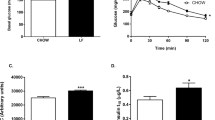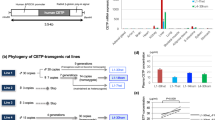Abstract
Various animal models of hyperlipidemia are used in research. Four rodent hyperlipidemia experimental models are examined in this study: three chronic hyperlipidemia models based on dietary supplementation with lipid or sucrose for 3 months and one acute hyperlipidemia model based on administration of the nonionic surfactant poloxamer. Neither lipid supplementation nor sucrose supplementation in Wistar rats was effective for establishing hyperlipidemia. Combining both lipid and sucrose supplementation in BALB/c mice induced hypercholesterolemia, as reflected in a considerable increase in blood cholesterol concentration, but did not produce an increase in blood triglyceride concentration. Poloxamer administration in C57BL/J6 mice produced increases in blood cholesterol and triglyceride concentrations. The authors conclude that supplementation of both lipid and sucrose in BALB/c mice was the most effective method for developing chronic hypercholesterolemia.
This is a preview of subscription content, access via your institution
Access options
Subscribe to this journal
We are sorry, but there is no personal subscription option available for your country.
Buy this article
- Purchase on Springer Link
- Instant access to full article PDF
Prices may be subject to local taxes which are calculated during checkout



Similar content being viewed by others
References
Palou, A., Bonet, M., Picó, C. & Rodríguez, A. Nutrigenómica y obesidad. Rev. Med. Univ. Navarra 48, 36–48 (2004).
Álvarez-Castro, P., Sangiao-Alvarellos, S., Brandón-Sandá, I. & Cordido, F. Función endocrina en la obesidad. Endocrinol. Nutr. 58, 422–432 (2011).
Elliott, S., Keim, N., Stern, J., Teff, K. & Havel, P. Fructose, weight gain, and the insulin resistance syndrome. Am. J. Clin. Nutr. 76, 911–922 (2002).
Basciano, H., Federico, L. & Adeli, K. Fructose, insulin resistance, and metabolic dyslipidemia. Nutr. Metab. (Lond.) 2, 5 (2005).
Joven, J. et al. The results in rodent models of atherosclerosis are not interchangeable: the influence of diet and strain. Atherosclerosis 195, e85–e92 (2007).
Fuster, J., Castillo, A., Zaragoza, C., Ibáñez, B. & Andrés, V. Animal models of atherosclerosis. Progr. Mol. Biol. Transl. Sci. 105, 1–23 (2012).
Lovati, M., West, C., Sirtori, C. & Beynen, A. Dietary animal proteins and cholesterol metabolism in rabbits. Br. J. Nutr. 64, 473–485 (1990).
Brandsch, C., Shukla, A., Hirche, F., Stangl, G.I. & Eder, K. Effect of proteins from beef, pork, and turkey meat on plasma and liver lipids of rats compared with casein and soy protein. Nutrition 22, 1162–1170 (2006).
Rabot, S. et al. Germ-free C57BL/6J mice are resistant to high-fat-diet-induced insulin resistance and have altered cholesterol metabolism. FASEB J. 24, 4948–4959 (2010).
Buettner, R., Schölmerich, J. & Bollheimer, L.C. High-fat diets: modeling the metabolic disorders of human obesity in rodents. Obesity (Silver Spring) 15, 798–808 (2007).
Tan, C. et al. Smad3 deficiency in mice protects against insulin resistance and obesity induced by a high-fat diet. Diabetes 60, 464–476 (2011).
Gil-Hernández, A., Ramírez-Tortosa, M., Aguilera-García, M. & Mesa-García, M. Modelos experimentales de enfermedad cardiovascular. Nutrición Hospitalaria 22, 169–177 (2007).
González, Y., Sánchez, C., Castillo, O., Tamayo, M. & Verdecía, B. Modelo experimental de hiperlipidemia con el empleo de caseína y grasas saturadas. Medicentro 14, 269–275 (2010).
Jürgens, H. et al. Consuming fructose-sweetened beverages increases body adiposity in mice. Obes. Res. 13, 1146–1156 (2005).
Rippe, J. & Angelopoulos, T. Sucrose, high-fructose corn syrup, and fructose, their metabolism and potential health effects: what do we really know? Adv. Nutr. 4, 236–245 (2013).
D'Alessandro, M.E., Chicco, A., Basabe, J.C. & Lombardo, Y.B. Relación lípidos y resistencia insulínica en un modelo experimental de dislipemia inducido por dieta rica en sacarosa. Rev. Argent. Endocrinol. Metab. 43, 3–15 (2006).
Pedraza, L.G.G. Evaluación de jarabe de maguey mezcalero (Agave salmiana) en ratas diabéticas. Thesis. (Universidad Autónoma de San Luis Potosí, San Luis Potosí, Mexico, 2006).
Fortino, M.A. Intervenciones nutricionales en un modelo experimental de dislipemia y resistencia insulínica inducido por ingesta prolongada de dieta rica en sacarosa. Efecto de la sustitución parcial del contenido de sacarosa dietaria. Thesis. (Universidad Nacional del Litoral, Santa Fe, Argentina, 2007).
Lomba, A. et al. Obesity induced by a pair-fed high fat sucrose diet: methylation and expression pattern of genes related to energy homeostasis. Lipids Health Dis. 9, 60 (2010).
Fonseca, V. et al. Effects of a high-fat-sucrose diet on enzymes in homocysteine metabolism in the rat. Metabolism 49, 736–741 (2000).
Uriarte, G., Paternain, L., Milagro, F., Martínez, J. & Campion, J. Shifting to a control diet after a high-fat, high-sucrose diet intake induces epigenetic changes in retroperitoneal adipocytes of Wistar rats. J. Physiol. Biochem. 69, 601–611 (2013).
Khanna, A.K., Chander, R., Singh, C., Srivastava, A.K. & Kapoor, N.K. Hypolipidemic activity of Achyranthes aspera Linn in normal and triton-induced hyperlipidemic rats. Indian J. Exp. Biol. 30, 128–130 (1992).
Tillán-Capó, J., Gómez-Mirabal, J. & Menéndez-Castillo, R. Efecto hipolipemiante de Aloe vera L. Rev. Cubana Plant. Med. 10 (2005).
Megallia, S., Aktanb, F., Davies, N. & Roufogalis, B. Phytopreventative anti-hyperlipidemic effects of gynostemma pentaphyllum in rats. J. Pharm. Pharm. Sci. 8, 507–515 (2005).
Singh-Joy, S. & McLain, V. Safety assessment of poloxamers 101, 105, 108, 122, 123, 124, 181, 182, 183, 184, 185, 188, 212, 215, 217, 231, 234, 235, 237, 238, 282, 284, 288, 331, 333, 334, 335, 338, 401, 402, 403, and 407, poloxamer 105 benzoate, and poloxamer 182 dibenzoate as used in cosmetics. Int. J. Toxicol. 27 (suppl. 2), 93–128 (2007).
Wood, S.C., Seeley, R.J., Rushing, P.A., D'Alessio, D. & Tso, P. A controlled high-fat diet induces an obese syndrome in rats. J. Nutr. 133, 1081–1087 (2003).
Alfonso Perez, C. & Ortiz, H. Efectos del aceite crudo de palma en los lípidos plasmáticos de conejos. Rev. Facultad Med. (Caracas) 24, 75–79 (2001).
Karaji-Bani, M., Montazeri, F. & Hashemi, M. Effect of palm oil on serum lipid profile in rats. Pakistan J. Nutr. 5, 234–236 (2006).
Scorza, T., Martucci, A. & Torrealba de Ron, A.T. Palm oil derivatives with different concentration of palmitic acid and antioxidants. Effects upon plasmatic lipids and platelet aggregation. Arch. Latinoam. Nutr. 49, 20–25 (1999).
Ros, E. Intestinal absorption of triglyceride and cholesterol. Dietary and pharmacological inhibition to reduce cardiovascular risk. Atherosclerosis 151, 357–379 (2000).
Novelli, E.L. et al. Anthropometrical parameters and markers of obesity in rats. Lab. Anim. 41, 111–119 (2007).
Ayala, I. et al. Modelos animales experimentales de enfermedad dehígado graso y síndrome metabólico. An. Vet. (Murcia) 24, 5–16 (2008).
Vásquez-Machado, M. & Ulate-Montero, G. Regulación del peso corporal y del apetito. Acta Médica Costarricense 52, 79–89 (2010).
Kok, N., Roberfroid, M. & Delzenne, N. Dietary oligofructose modifies the impact of fructose on hepatic triacylglycerol metabolism. Metabolism 45, 1547–1550 (1996).
Roglans, N., Vilà, L. & Laguna, J. Reducción en la actividad de transactivación y transrepresión de PPAR en un modelo experimental. Clin. Invest. Arterioscl. 19, 1–12 (2007).
Mayes, P.A. Intermediary metabolism of fructose. Am. J. Clin. Nutr. 58, 754S–765S (1993).
Stanhope, K. Role of fructose-containing sugars in the epidemics of obesity and metabolic syndrome. Annu. Rev. Med. 63, 329–343 (2012).
Oron-Herman, M. et al. Metabolic syndrome: comparison of the two commonly used animal models. Am. J. Hypertens. 21, 1018–1022 (2008).
Satapathy, S.K. et al. Galantamine alleviates inflammation and other obesity-associated complications in high-fat diet–fed mice. Mol. Med. 17, 599–606 (2011).
Xu, X. et al. Insulin signaling regulates fatty acid catabolism at the level of CoA activation. PLoS Genet. 8, e1002478 (2012).
Wasan, K.M. et al. Poloxamer 407-mediated alterations in the activities of enzymes regulating lipid metabolism in rats. J. Pharm. Pharm. Sci. 6, 189–197 (2003).
Acknowledgements
We thank Yuliet González Madariaga, Head of Foreign Language Department of Central University Marta Abreu of Las Villas, for her help with the English translation of this paper.
Author information
Authors and Affiliations
Corresponding author
Ethics declarations
Competing interests
The authors declare no competing financial interests.
Rights and permissions
About this article
Cite this article
Madariaga, Y., Cárdenas, M., Irsula, M. et al. Assessment of four experimental models of hyperlipidemia. Lab Anim 44, 135–140 (2015). https://doi.org/10.1038/laban.710
Received:
Accepted:
Published:
Issue Date:
DOI: https://doi.org/10.1038/laban.710
This article is cited by
-
Phytoconstituents of an ethanolic pod extract of Prosopis cineraria triggers the inhibition of HMG-CoA reductase and the regression of atherosclerotic plaque in hypercholesterolemic rabbits
Lipids in Health and Disease (2020)
-
A comparative study between Wuweizi seed and its post-ethanol extraction residue in normal and hypercholesterolemic mice
Lipids in Health and Disease (2015)



